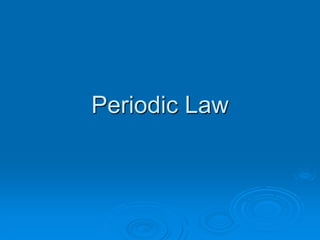
periodic table_sedgefield.ppt
- 1. Periodic Law
- 2. SPS1. Obtain, evaluate, and communicate information from the Periodic Table to explain the relative properties of elements based on patterns of atomic structure. b.Analyze and interpret data to determine trends of the following: Number of valence electrons Types of ions formed by main group elements Location and properties of metals, nonmetals, and metalloids Phases at room temperature c. Use the Periodic Table as a model to predict the above properties of main group elements.
- 3. How is the periodic table arranged? What do elements on the same row have in common? What do elements in the same column have in common?
- 4. How does its location on the periodic table help you to predict the peoperties of an element?
- 5. You should know the how the periodic table is arranged You should know what elements on the same rows and columns have in common You should know the trends of the periodic table including reactivity and atomic radius change
- 6. Origin of the Periodic Table Mendeleev proposed the first arrangement of the periodic table. Arranged by atomic mass Found that as he arranged the elements, similar properties repeated themselves.
- 8. Origin of the Periodic Table There were “gaps” in his table, which led other scientists to discover new elements. Moseley devised the current periodic table which is based on ATOMIC NUMBER
- 9. The Periodic Table Periodic means “repeating” pattern. The periodic table groups similar elements together (think about sections in the grocery store). Grouping makes it easier to predict the properties of an element.
- 10. Periodic Law States that the repeating chemical and physical properties of elements change periodically with the atomic numbers of the elements.
- 11. Periods Periods: horizontal rows of elements (7) Just as the number of protons changes as you move from left to right across the periodic table, so does the number of electrons. Remember that sentences are written in rows and end with a period.
- 13. Groups Groups: Vertical column of elements on the periodic table (18) Remember that group is spelled group and groups go up and down. Elements in the same group have the same number of valence electrons.
- 14. Groups Remember, valence electrons determine an element’s properties so all elements in the same group have similar properties. What makes them different then???
- 16. Oxidation Number Tells how many electrons can be gained or lost when an element reacts with other elements. A positive oxidation number means it will LOSE electrons (Ex. Sodium= +1) A negative oxidation number means it will GAIN electrons (Ex. Oxygen= -2)
- 17. (Group 14 has + or – 4)
- 18. Families of Elements Think of each element as a member of a family that is related to other elements nearby. Elements are classified as metals, nonmetals or metalloids Groups are sometimes referred to as families
- 21. Metals Physical Properties: Shiny (luster), good conductors, high density, ductile (can be made into thin wires), malleable (can be hammered into thin sheets) and most are silver Chemical Properties: Corrosion (wearing away because of a chemical reaction with water), reactivity (bond with other atoms)
- 22. Metals
- 24. Types of Metals 1. Alkali Metals: very reactive 2. Alkaline-Earth Metals: form compounds that are found in our bodies (calcium and magnesium compounds) 3. Transition Metals: the properties gradually change from being more similar to Group 2 to being more like Group 13 (Gold, Silver and Platinum)
- 25. Nonmetals Physical Properties: No luster, not conductors, brittle, not ductile, low density, and many are gaseous (can be solids or liquids too though) Chemical Properties: Highly reactive All, except for hydrogen, are on the right hand side of the periodic table.
- 27. Types of Nonmetals 1. Halogens: Group 17 (Ex. Chlorine). Combine with most metals to form salts. 2. Noble Gases: Inert (unreactive) and do not form with other atoms to make compounds
- 28. Metalloids (Semconductors) Properties: shiny or dull, conductors (but not as good as metals), ductile and malleable There are only 6 total
- 29. Lanthanides and Actinides Rare earth elements Most of the actinides have been synthesized by nuclear scientists (except for uranium and thorium)
- 32. Periodic Trends Labeling Directions 1. Label the number of valence electrons at the at the top of each group. 2. Label the oxidation number at the bottom of each group.
- 33. 3. Label the following groups: • Alkali Metals • Alkaline Earth Metals • Transition Metals • Boron Group • Carbon Group • Nitrogen Group • Oxygen Group • Halogens (only group with all 3 states of matter!) • Noble Gases • Lanthanides • Actinides
- 34. Valence Electrons are: The electrons in the outermost shell Responsible for atomic bonding Equal to the last digit of the group number How many valence electrons in this atom? What group would it be in? Valence electrons